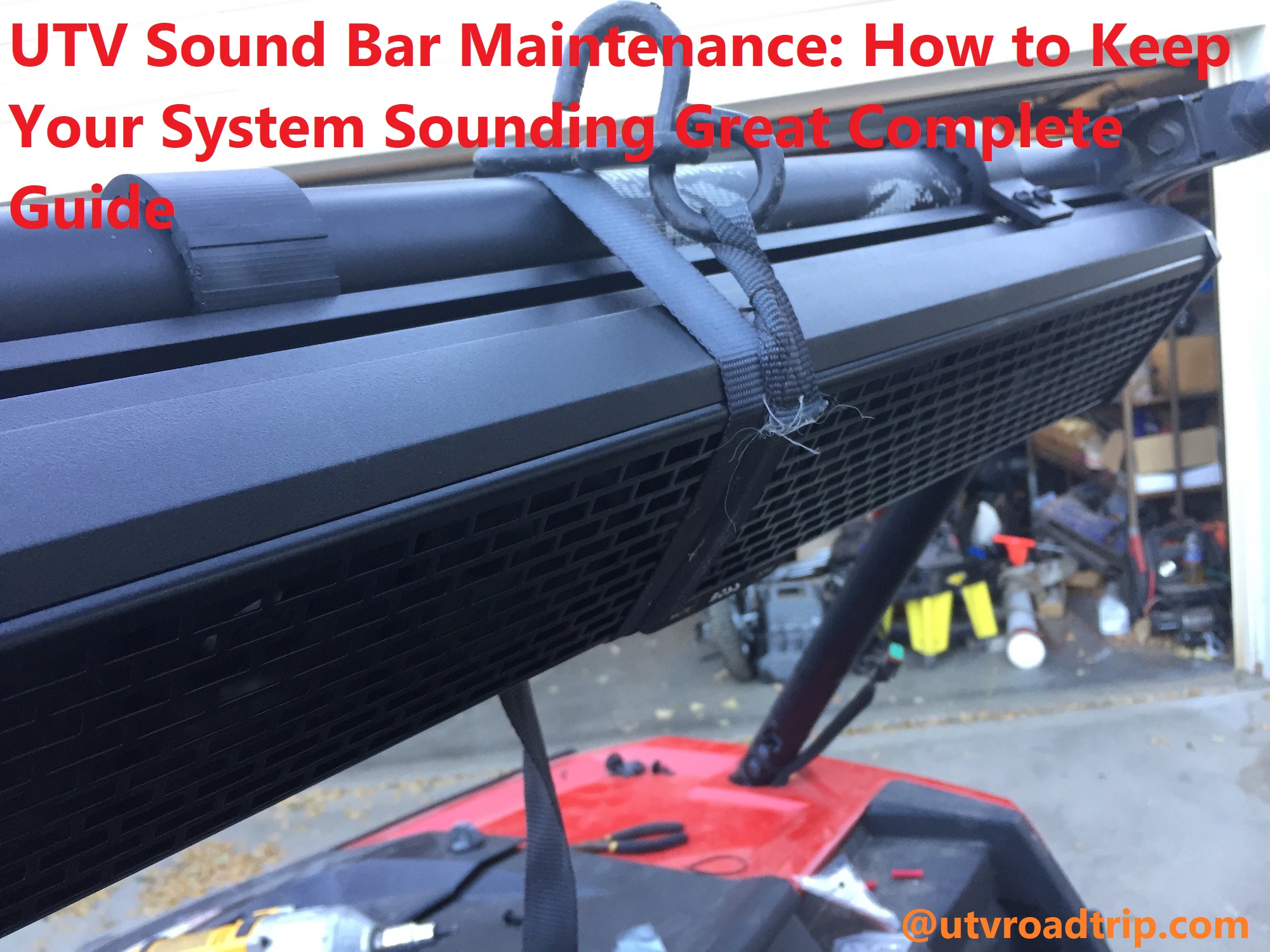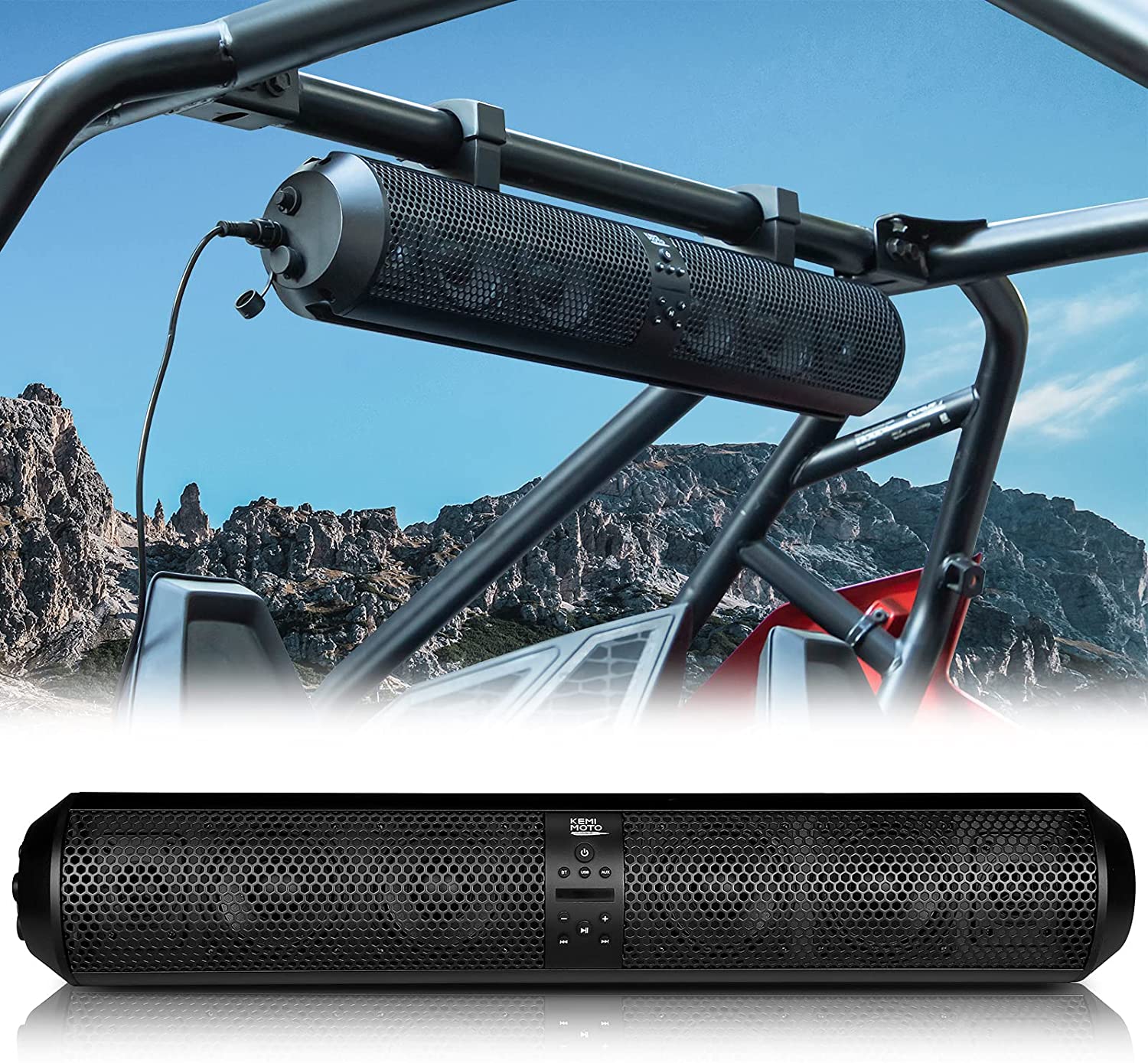Are you looking for the best way to keep your UTV sound bar sounding perfect? Your search ends here!
You’ll find all the advice and tips needed to get maximum output from your UTV sound bar. We’ve put together a comprehensive guide containing all you need to know about UTV sound bar maintenance.
Welcome to the complete guide to UTV sound bar maintenance! Whether you’re a UTV enthusiast, competition rider, full-time off-roader, or just someone who loves to get out and explore nature on the weekends, having a great sound system in your vehicle is essential for creating the perfect riding experience. A well-maintained sound bar will provide clear and loud audio no matter where you take your adventures. In this guide, we’ll go over everything you need to know about taking proper care of your UTV’s sound system.
We’ll cover:
- How to go about installing your dash speakers and sound bar.
- What materials and tools are needed for basic maintenance.
- Tips for extending life expectancy of components.
- Creative solutions for difficult installations.
At the end of this article, you should have a better understanding of how regular maintenance can help keep your UTV’s audio system running in top condition while keeping an eye on budget restraints as well. Let’s dive right in!
Cleaning the UTV Sound Bar
Now that you have a thorough understanding of the components in a UTV sound system, it is time to explore how to keep them clean and functioning optimally. The most important cleaning tips for UTV sound bars involve regular care and maintenance. Due to their proximity to the open road, UTV sound bars are exposed to dirt, dust, and grit at all times. This can cause sound issues and other malfunctions if not addressed in a timely manner.
For gentle cleaning of the outside of your UTV sound bar, experts recommend using a soft cloth or brush as well as mild soap and water mixture. A LED light should be used to find any stubborn spots that may be difficult to reach with the cloth or brush. Be sure not to use any abrasive cloths or rubbing alcohol as they could damage the protective coating on your unit’s outer shell. Additionally, special attention should be given around any exposed wire connections on the control panel since corrision can occur due to extended exposure to moisture or water.
When cleaning inside your UTV sound bar, unplugging the unit from its power source is key for safety reasons. Experts recommend using compressed air canisters set at low pressure when cleaning small crevices inside your system’s control panel or speaker housings. Additionally, pay special attention when blasting compressed air around wire connections when removing dust particles from wiring harnesses or speakers as too much pressure could break or damage them further down the line.

Tools needed for cleaning
Carefully assemble the items you need to effectively and accurately clean your UTV sound bar system. Ensure you have the following items before you get started:
-Soft brush or rag to dust components and wipe surfaces
-Compressed air (electronic grade) for removing debris from hard-to-reach areas
-Isopropyl alcohol wipes to clean the touch controls, display and cabinet sizes
-Cotton swabs saturated in alcohol to clean any exposed sound board connectors
-UL approved silicone spray specifically designed for electronic components
-Staticide® anti-static fabric spray for cleaning audio/video cables
-Soft cloths or towels
-Equipment glides – lubricate cabinet moving parts periodically
By having these materials close at hand, it is easier and faster to accomplish regular maintenance of your UTV sound bar system. Make sure you keep these tools organized by placing them in a designated storage spot. This will help ensure that they are available each time maintenance is needed. It is also important that ventilation be maintained in your system as well as when using any of the above listed items.
Step-by-step guide to cleaning
This guide will walk you through step-by-step instructions on how to properly and effectively clean your UTV sound bar system. By taking the time to properly maintain your sound bar system, you can ensure your system will sound amazing for years to come!
- Unplug the power cords from both the amplifier and speakers. Take note of any connections or fuses that may become disconnected during cleaning, and make sure all the wires are not twisted or damaged before re-connecting.
- Using a soft, dry cloth, gently wipe down the exterior of all components in order to remove dust and dirt. Be especially careful with speaker grilles, as these can be easily damaged if rubbed too harshly. Do not attempt to use chemicals or solvents on your system as these may cause permanent damage.
- Take a can of compressed air and spray into each individual speaker opening in order to remove built-up dirt and debris buildup inside the cabinet. This will help improve audio performance and reduce sound distortion caused by a buildup of dust particles drying out foam components over time. Make sure you hold the can at least 8 inches away from the speaker when spraying – this will prevent any moisture build-up that could potentially damage delicate speaker cone material inside the cabinet.
- Check all wires for wear and tear, ensuring there are no broken strands present along any part of its length – if so determine necessary changes for safety reasonsand replace or repair wire(s). Also ensure all wire connectors are properly tightened with no signs of corrosion or oxidation around any connection points on either end of each wire – if needed these should also be replaced or repaired for safety reasons as mentioned above prior reconnecting back into place / position prior cleaning commenced originally..
5 Use a damp cloth with warm soapy water (or an approved electronic cleaner) to wipe down exposed areas within amplifier casing completely making sure it is completely dry before powering back up again after cleaning has been done..
Protecting the UTV Sound Bar from Weather Elements
Protecting the UTV sound bar from weather elements is an important part of keeping the system in excellent condition. To do this, you should make sure the sound bar is properly sealed or covered when not in use, especially if you live in a hot climate where temperatures can become extremely high.
Additionally, be sure to keep the sound bar away from pooling water and areas where it will be exposed to direct sunlight or rain. Also, if you’re using your UTV off-road, make sure not to take it places too extreme. If possible, try to stick to softer terrain that won’t cause too much vibration against the sound bar.
Importance of protecting from weather elements
To keep your UTV sound bar system in peak performance for a long time, it is essential to protect it from rain, snow, dust and other environmental elements. Exposure to the elements can cause corrosion on the outside of the sound bar as well as damage to the internal wiring and components.
To protect against water damage, you should purchase a waterproof cover to slip over your sound bar when not in use. This will help keep moisture from getting inside of the sound bar and damaging its components. Additionally, keep your system away from carbon monoxide. When exposed for too long this poisonous gas can cause permanent harm to your UTV sound bar’s electronics.
It is also important that you regularly clean off any dirt or debris that builds up on the outside of your sound bar to ensure its longevity. Using a soft cloth or sponge, gently wipe down all exterior surfaces of the soundbar with warm soapy water every few weeks to help prevent any dirt or dust particles from settling into crevices and causing corrosion or potentially interfering with audio quality.
Covering the sound bar
Covering your sound bar with a protective audio cover is an ideal way to protect it from dust, moisture, and other environmental elements. These covers should fit snugly over your sound bar and must be made from a durable material that is resistant to tears and fading. Of course, the design of the cover should enhance the look of your system too!
Some factors to consider when choosing covers include:
-Material – some are constructed from canvas or heavy-duty cargo fabric. Select one that is designed for outdoor use for added protection against nature’s elements.
-Size – make sure you measure the sound bar before purchasing a cover so that you get one that fits properly.
-Features – Many covers include pockets or compartments to store cords, remotes, iPod/MP3 players or even snacks!
Maintaining the UTV Sound Bar Battery
When it comes to UTV sound bars, one of the most important parts is the battery. The battery helps power all of the components in your system, so it’s important to make sure you’re taking proper care of it. To maintain peak performance from your UTV sound bar, there are a few key steps and precautions that you can take to keep the battery healthy and functioning.
First, whenever possible, avoid fully draining your battery before proceeding with recharging. It’s best to keep your battery at least roughly half full for best results. Keeping an eye on the charge level through either manual or automatic monitoring systems can help ensure that you don’t let it get too low.
Secondly, periodically use a voltage checker to ensure that the battery is getting enough power to function at peak levels. This can help identify small issues before they become bigger problems down the road. If necessary, you may even need to recharge your battery completely if it shows signs of diminished performance over time.
Finally, when storing your system with a battery attached for extended periods of time (more than two weeks), disconnect the terminals and store in cool area away from direct sunlight or extreme temperatures for optimal results.
Types of batteries used in UTV sound bars
The type of battery used in a UTV sound bar, also known as a side-by-side or ROV audio system, varies based on the brand and model. Generally speaking, many UTV sound bars use rechargeable lithium-ion or lead acid deep cycle batteries as their source of power.
Lithium-ion batteries are typically cylindrical in shape and much smaller in size than traditional lead acid batteries. They are generally easier to use and maintain, provide a consistent power output and can last up to twice as long when compared to lead acid batteries. On the downside, they can be more expensive and require additional components like a battery charger if you wish to keep your device maintained and powered over time.
Lead acid deep cycle batteries have been around for decades now and are well proven in terms of reliability. However, they are significantly larger than their lithium counterparts so tend not to fit into some UTV coffee units with ease; furthermore, as these packages do not contain a battery charger it’s important to keep them topped off during long periods of non-use which can be an issue if you’re away from home. Fortunately, these packages also tend to be much less expensive than those that include lithium-ion alternatives; servicing is also simpler due to the easy connection points featured within the casing.

Signs of a weak battery
While the battery of your UTV sound bar can last for many years, it may eventually become weak and fail to provide power for the system. If your sound system has been turning off unexpectedly or experiencing intermittent issues of loss of sound, a weak battery may very well be the culprit.
Other signs to look out for include buzzing sounds from the speakers, sudden and drastic sound drops in certain areas, lack of power indicator light and an inability to detect audio sources. It’s important to diagnose the exact cause behind a weakened battery in order to replace it with a new one that will get your system back up and running again.
Upgrading Your UTV Sound System
Upgrading your UTV sound system is a great way to get the most out of your UTV. Bigger, louder speakers can provide bigger, better sound effects and you can usually install them yourself or have someone do it for you. When upgrading, there are a few things to consider.
First, determine what type of system you have. There are different types of systems that are designed for bass, midrange or treble frequencies. This means that certain upgrades may work better than others depending on the type of system you have and the kind of sounds you’re looking for.
Once you know the type of system you’re dealing with, consider the size and power rating of the speakers and components available for it. You want to make sure that any new components are compatible with your existing setup so that they will produce quality sound without interference or distortion.
Finally, if possible try to test out different components before purchasing anything so that you know exactly what kind of sounds they will produce in any given environment before making a purchase. Don’t forget about comfort options like wireless remotes and subwoofers as these can add convenience and flexibility!
When to consider upgrading
If you want to keep your UTV sound bar sounding its best, it is important to assess the need for upgrading audio components. Many UTV sound bars come with basic or stock speakers, but they might not offer the sound you were hoping for. Upgrading your sound bar can dramatically change the quality of sound in your vehicle and improve overall performance.
If you are looking for higher performance and better clarity, consider investing in a more robust upgrade package with higher quality components such as specialty audio cables, tweeters and woofers. It’s important to note that adding an amplifier will amplify low-level noises from factory wiring and may overload/damage these parts of the system if not installed properly. Have a trained professional perform any upgrades prior to installation to ensure everything is done correctly.
Choosing the right upgrade
When it’s time to upgrade your UTV sound bar system, you’ll want to choose components that fit your budget, provide the perfect balance of power and efficiency for your UTV, and provide great sound quality overall.
Before purchasing any new speakers or amplifiers for your UTV, you’ll need to determine how much wattage each component will require. Many aftermarket sound bars come equipped with smaller amplifier models that draw less power than larger models. To maximize the sound bar’s potential output, consider bigger speakers with more wattage and build a box built specifically for loud sound or choose higher-powered components such as subwoofers and dedicated amplifiers to deliver maximum audio performance.
Additionally, some systems may require additional crossover components such as line level converters or bass control settings. These features can be used to ensure optimal performance from various sources like phones or tablets while using the same wired or wireless compatible device. Additionally, you’ll want to make sure all of the cables are securely connected between each component so power is efficiently transmitted properly from one device to another.
By researching and understanding the recommended specifications for each component before beginning work on upgrading your UTV sound bar system, you can be sure that your investment will be worthwhile in terms of both performance and cost effectiveness.
Conclusion
The great sound quality of your UTV sound bar is highly dependent on its care and maintenance, so it’s important to always keep it in good condition. Regularly check the system for any signs of rust, dirt or debris buildup, loose screws and bolts, or broken wires. Clean the various components with a soft cloth that is specifically designed for use on electronics.
Finally, review your owner’s guide to ensure that all settings and connections are properly applied before each use.
By following these maintenance tips, you can enjoy a great sounding UTV sound bar for years to come. With proper upkeep and regular cleaning schedules, you’ll achieve superior performance year after year – helping you get the most out of every journey!

FAQ’S
How can I improve my soundbar sound quality?
You can improve your soundbar sound quality by optimizing placement, adjusting EQ settings, adding a subwoofer, upgrading cables, and reducing background noise.
How do you maintain a sound system?
To maintain a sound system, you should regularly clean components, check and replace cables as needed, update firmware, and keep the system free of dust and debris.
Is it OK to leave soundbar on all the time?
It is generally not recommended to leave a soundbar on all the time, as it can cause overheating and potentially shorten the lifespan of the device.
What are common problems with soundbars?
Common problems with soundbars include connectivity issues, poor sound quality, power issues, and compatibility problems with other devices.
What improves sound quality?
Improvements to sound quality can be made by upgrading components, optimizing placement, adjusting EQ settings, and reducing background noise.
What improves audio quality?
Improvements to audio quality can be made by using high-quality components, optimizing placement, adjusting EQ settings, and reducing background noise.
What is the most important thing in a soundbar?
The most important thing in a soundbar is the audio quality, including clarity, depth, and balance.
What are the best equalizer settings for soundbar?
The best equalizer settings for a soundbar will depend on personal preference and the specific model of the soundbar, but adjustments to bass, treble, and midrange can often improve sound quality.
What is the best audio option for soundbar?
The best audio option for a soundbar will depend on the specific needs and preferences of the user, but options such as Dolby Atmos, DTS:X, and virtual surround sound can improve the listening experience.
Why does my soundbar sound so bad?
There are several reasons why a soundbar may sound bad, including poor placement, incorrect settings, damaged components, interference, and compatibility issues with other devices.
See Also :
- Best utv beadlock wheels
- Best utv bluetooth speakers
- Best utv cell phone holder
- Best utv cleaner
- Best utv covers


